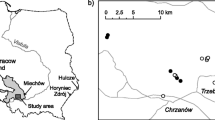Abstract
Aspects of the bioaccumulation of heavy metals are reviewed and possible evidence of homeostasis is highlighted. Examination and analysis of olive (Olea europaea L.) trees growing in close proximity to a copper dominated spoil tip dating from at least 2000 years BP, on the island of Cyprus, revealed both bioaccumulation and partitioning of copper, lead and zinc in various parts of the tree. A factor to quantify the degree of accumulation is illustrated and a possible seed protective mechanism suggested.

Similar content being viewed by others
References
Boon GT, Bouwman LA, Bloem J, Rőmkens PFAM (1998) Effects of copper-tolerant grass (Agrostis calillaris) on the ecosystem of copper contaminated arable soil. Environ Toxicol Chem 17:1964–1971
DEFRA (2002) Contaminated Land Exposure Assessment (CLEA 2002). UK Department for Environment, Food and Rural Affairs, London
Maisto G, Alfani A, Baldantoni D, De Marco A, De Santo AV (2004) Trace metals in the soil and in Quercus ilex L. leaves at anthropic and remote sites of the Campania region of Italy. Geoderma 122:269–279
Malawska M, Wilkomirska B (2001) An analysis of soil and plant (Taraxacum officinale) contamination with heavy metals and polycyclic aromatic hydrocarbons (PAHs) in the area of a railway junction Ilawa Glowna, Poland. Water Air Soil Pollut. 127:339–349
Pyatt FB (1999) Comparison of Foliar and Stem Bioaccumulation of heavy Metals by Corsican Pines in the Mount Olympus Area of Cyprus. Ecotoxicol Environ Safety 42:57–61
Pyatt FB (2001) Copper and lead bioaccumulation by Acacia retinoides and Eucalyptus torquata in sites contaminated as a consequence of extensive Ancient mining activities in Cyprus. Ecotox Environ Safety 50:60–64
Pyatt FB, Birch P (1994) Atmospheric erosion of metalliferous spoil tips: some localised effects. Polish J Environ Stud 4:351–353
Raber PA (1984) Organization and development of early copper metallurgy in the Polis region, western Cyprus. PhD thesis Pennsylvania State University
Radofevic M, Bashkin VN (1999) Practical environmental analysis. The Royal Society of Chemistry, Cambridge
Walker DJ, Clemete R, Bernal M (2004) Contrasting effects of manure and compost on soil pH, heavy metal availability and growth of Chenopodium album L. in a soil contaminated by pyritic mine waste. Chemosphere 57:215–224
Wilson B, Lang B, Pyatt FB (2005a) The dispersion of heavy metals in the vicinity of Britannia Mine, British Columbia, Canada. Ecotoxicol Environ Safety 60:269–276
Wilson B, Braithwaite A, Pyatt FB (2005b) An evaluation of procedures for the digestion of soils and vegetation from areas with metalliferous pollution. Toxicol Environ Chem 87:335–344
Wilson B, Pyatt FB (2006) Bio-availability of tungsten in the vicinity of an abandoned mine in the English Lake District and some potential health implications. Sci Total Environ 370:401–408
Wilson B., Pyatt FB (2007). Heavy metal dispersion, persistence and bioaccumulation around an ancient copper mine situated in Anglesey. UK. Ecotoxicol Environ Safety 66:224–231
Yukselen MA, Alpaslan B (2001) Leaching of metals from soil contaminated by mining activities. J Hazardous Mater B87:289–300
Acknowledgments
Higher Education Funding Council for England who provided financial assistance to Bob Wilson.
Author information
Authors and Affiliations
Corresponding author
Rights and permissions
About this article
Cite this article
Wilson, B., Pyatt, F.B. Heavy Metal Bioaccumulation by the Important Food Plant, Olea europaea L., in an Ancient Metalliferous Polluted Area of Cyprus. Bull Environ Contam Toxicol 78, 390–394 (2007). https://doi.org/10.1007/s00128-007-9162-2
Received:
Accepted:
Published:
Issue Date:
DOI: https://doi.org/10.1007/s00128-007-9162-2




